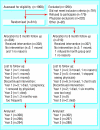Randomised equivalence trial comparing three month and six month follow up of patients with hypertension by family practitioners
- PMID: 14726370
- PMCID: PMC318487
- DOI: 10.1136/bmj.37967.374063.EE
Randomised equivalence trial comparing three month and six month follow up of patients with hypertension by family practitioners
Abstract
Objective: To compare blood pressure control, satisfaction, and adherence to drug treatment in patients with treated hypertension followed up by their family physicians either every three months or every six months for three years.
Design: Randomised equivalence clinical trial. Settings 50 family practices in south eastern Ontario, Canada.
Participants: 609 patients aged 30-74 years with essential hypertension receiving drug treatment whose hypertension had been controlled for at least three months before entry into the study.
Results: 302 patients were randomly assigned to follow up every three months and 307 to follow up every six months. Baseline variables in the two groups were similar. As expected, patients in the six month group had significantly fewer visits, but patients in both groups visited their doctor more frequently than their assigned interval. Mean blood pressure was similar in the groups, as was control of hypertension. Patient satisfaction and adherence to treatment were similar in the groups. About 20% of patients in each group had blood pressures that were out of control during the study.
Conclusions: Follow up of patients with treated essential hypertension every six months is equivalent to follow up every three months. Patient satisfaction and adherence to treatment are the same for these follow up intervals. As about 20% of patients' hypertension was out of control at any time during the study in both groups, the frequency of follow up may not the most important factor in the control of patients' hypertension by family practitioners.
Figures
Comment in
-
Follow up of hypertension by family practitioners: select sample and absolute risk of cardiovascular disease.BMJ. 2004 Mar 13;328(7440):641; author reply 641-2. doi: 10.1136/bmj.328.7440.641-a. BMJ. 2004. PMID: 15016700 Free PMC article. No abstract available.
-
Follow up of hypertension by family practitioners: technique should be taught at school.BMJ. 2004 Mar 13;328(7440):641; author reply 641-2. doi: 10.1136/bmj.328.7440.641-b. BMJ. 2004. PMID: 15016701 Free PMC article. No abstract available.
References
-
- Joint National Committee on Prevention, Detection, Evaluation, and Treatment of High Blood Pressure. Sixth report. Bethesda: National Institutes of Health, 1997. (NIH publication No 98-4080.)
-
- Joffres MR, Hamet P, MacLean DR, L'italien GL, Fodor G. Distribution of blood pressure and hypertension in Canada and the United States. AJH 2001;14: 1099-105. - PubMed
-
- Burt VL, Cutler JA, Higgins M, Horan MJ, Labarthe D, Whelton P, et al. Trends in the prevalence, awareness, treatment, and control of hypertension in the adult US population. Data from the health examination surveys, 1960 to 1991. Hypertension 1995;26: 60-9. - PubMed
-
- Chobanian AV, Bakris GL, Black HR, Cushman WC, Green LE, Izzo JL, et al. The seventh report of the Joint National Committee on Prevention, Detection, Evaluation, and Treatment of High Blood Pressure. JAMA 2003;289: 2560-72. - PubMed
-
- Ramsay LE, Williams B, Johnston GD, MacGregor GA, Poston L, Potter JF, et al for the British Hypertension Society. Guidelines for management of hypertension: report of the third working party of the British Hypertension Society. J Hum Hypertensn 1999;13: 569-92. - PubMed
Publication types
MeSH terms
LinkOut - more resources
Full Text Sources
Medical
Research Materials

